Philosophy
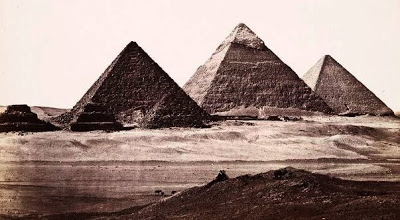 Now physics will probe the ancient pyramids.
Now physics will probe the ancient pyramids.
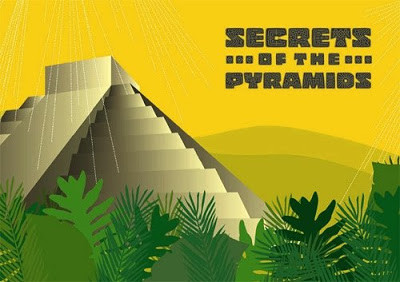 In the dense jungles of northwestern Belize, the sound of metal hitting rock startles flocks of tropical birds and troops of black howler monkeys. Archaeologist Norman Hammond and his team stop digging. They have hit a stone wall 10 feet below ground; inside is a royal tomb. After almost one hundred test excavations at La Milpa, an ancient Mayan city of 50,000 people, Hammond has unearthed something big. Within the tomb lie the remains of a man wearing a jade pendant in the form of a vulture's head. He is thought to be either Bird Jaguar, the fifth-century ruler of La Milpa, or one of Bird Jaguar’s successors. And finding him was an incredible stroke of luck. Hammond made his famous discovery more than 10 years ago, but repeated efforts to find other tombs at the site have come up empty-handed. Lacking an ancient map of La Milpa or blueprints for its five pyramid mounds and buried plaza, archaeologists rely mostly on instinct. They run the risk of piercing priceless relics with their shovels or digging fruitlessly for years. The ground beneath the site "could be Swiss cheese, for all we know," riddled with burial chambers, tunnels, and hidden entrances, says Hammond, who is based at Boston University. Now researchers hope to find those hidden spaces with the help of particle physics.
In the dense jungles of northwestern Belize, the sound of metal hitting rock startles flocks of tropical birds and troops of black howler monkeys. Archaeologist Norman Hammond and his team stop digging. They have hit a stone wall 10 feet below ground; inside is a royal tomb. After almost one hundred test excavations at La Milpa, an ancient Mayan city of 50,000 people, Hammond has unearthed something big. Within the tomb lie the remains of a man wearing a jade pendant in the form of a vulture's head. He is thought to be either Bird Jaguar, the fifth-century ruler of La Milpa, or one of Bird Jaguar’s successors. And finding him was an incredible stroke of luck. Hammond made his famous discovery more than 10 years ago, but repeated efforts to find other tombs at the site have come up empty-handed. Lacking an ancient map of La Milpa or blueprints for its five pyramid mounds and buried plaza, archaeologists rely mostly on instinct. They run the risk of piercing priceless relics with their shovels or digging fruitlessly for years. The ground beneath the site "could be Swiss cheese, for all we know," riddled with burial chambers, tunnels, and hidden entrances, says Hammond, who is based at Boston University. Now researchers hope to find those hidden spaces with the help of particle physics.
A cosmic X-ray machine
The key to the new approach is the muon, a heavy cousin of the electron that's created when cosmic rays hit the atmosphere. Muons pass harmlessly through people and buildings; in fact, nearly 600 of them fly through your body each minute. They fascinate scientists because they’re one of the few high-energy particles raining down from the sky that can be examined for clues to the nature of the cosmos. Particle physicists started building muon detectors in the 1940s and they're still at it today; the most advanced particle detectors in the world, at the Large Hadron Collider in Geneva, Switzerland, have components that record muons created in particle collisions. But it's the ability of the muon to penetrate deep into rock and water that has archaeologists excited. Muons traveling through rock or other dense material will slow and eventually stop, while those flying through empty spaces keep going fullspeed. The idea is to catch the muons after they’ve passed through an archaeological site and measure their energies and trajectories. With this information, researchers can reconstruct their paths and compile a 3D image that reveals hidden chambers or other voids.
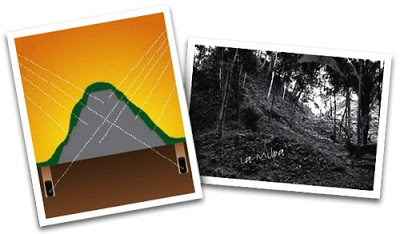 La Milpa
La Milpa
Scientists at the University of Texas at Austin plan to place two muon detectors on either side of a pyramid at La Milpa in Belize. This arrangement gives them a stereo view of the site, making it easier to compile a 3D image.
If archaeologists are like surgeons probing a patient, physicists are the radiologists whose X-rays show where to cut and how to do it safely. Just as X-rays leave patients unscarred, muons offer a way to explore ancient ruins without disturbing them. This fall, a team led by Arturo Menchaca-Rocha of the National Autonomous University of Mexico, or UNAM, plans to place a muon detector beneath the Pyramid of the Sun in Teotihuacán, northwest of Mexico City. Meanwhile, Roy Schwitters of the University of Texas at Austin is making plans to install muon detectors in wells dug on opposite sides of a mound at La Milpa. The detectors will gather muons for about a year, slowly building a picture of the interior of each pyramid.
First stop: Egypt
Muon detectors have a rich history of revealing the unusual and the unseen. Sixty years ago, scientists in Australia used them to measure layers of mountain snow. Today, Japanese scientists are testing the technology as a way to track magma rising within volcanoes, a possible sign of impending eruption. Border patrol agencies in the United States see muon detectors as a potential way to uncover radioactive materials shielded and hidden inside cargo containers and trucks.
It was about 40 years ago that archaeologists tapped muons for the first time. Luis Alvarez, a Nobel Prize-winning physicist at the University of California, Berkeley, wondered if muons might reveal chambers in the Second Pyramid of Chephren, one of the three great pyramids of Egypt, that had somehow escaped the notice of archaeologists and looters for 4500 years.
Alvarez and his team put a detector in the Belzoni Chamber, near the center of the pyramid’s base, and left it to collect muons for two years. They concluded that no additional chambers were hidden in the limestone above, although the scan was able to distinguish the four edges of the pyramid and what little remained of its smooth limestone facing. While it would have been more exciting to discover a new chamber, this information was nonetheless valuable for Egyptologists and archaeologists studying the pyramid—and it showed that the technique worked.
There are other high-tech ways to explore a ruin. Ground-penetrating radar reflects off buried features, while electrical-resistivity probes measure the increased resistance to electrical flow due to the presence of stone and brick. Though useful, neither of them probes as deeply or takes as wide a view as the muon detector does.
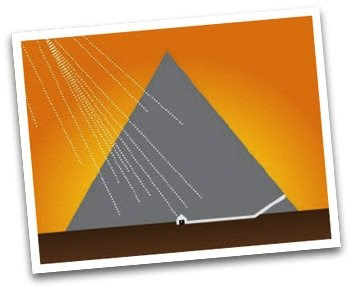 Egypt
Egypt
In the first experiment of its kind, a team led by Luis Alvarez placed a muon detector in a chamber of Egypt’s Second Pyramid of Chephren. Although the muons revealed no hidden chambers, the experiment showed that the method had value for archaeology.
The Pyramid of the Sun
In the early 1970s, a pair of archaeologists cleared stone and gravel out of a well at the base of the world’s third-largest pyramid, the Pyramid of the Sun at Teotihuacán. Beneath the rocks they found a stairway leading to a tunnel 100 meters long and eight meters below ground. It opened an extraordinary opportunity for the physics community, Menchaca-Rocha says: "It is the key that will allow us to carry out an experiment similar to that of Alvarez" by placing a muon detector directly below the pyramid.
Menchaca-Rocha hopes to put the detector in place this fall and begin collecting data by the end of the year.
The detector contains six gas-filled chambers. When a muon travels through one of them, it collides with particles in the gas and gives off light. By recording those light flashes and noting exactly where the muon entered and left the chamber, researchers can calculate its energy and trajectory. Menchaca-Rocha thinks the detector will reveal any cavity more than 75 centimeters—30 inches—tall.
The results could help to answer a question that has stumped archaeologists for decades: What was the purpose of the pyramid?
Linda Manzanilla, an archaeologist with UNAM, studies Teotihuacán, once a bustling center full of pyramids and temples. "It was a city that attracted many people," she says, "and it flourished for five centuries." She believes a volcanic eruption drove people from the north towards the valley where the metropolis rose; "There they built a temple to appease the fire gods."
Originally devoted to agriculture, the temple became a symbol of the state and its rulers. Could one of those rulers lie in a tomb within the Pyramid of the Sun? "I don’t think so. I don’t believe we will find anything inside," Manzanilla says. No tombs have been found there yet, and she doesn’t think that will change.
But without a muon detector, Manzanilla can't test her predictions. "The Pyramid of the Sun is so wide and so high," she says. "Ground-penetrating radar can see only a small depth and width. We can expand that view using the muon detector."
And, she hopes, put to rest speculation about what is inside.
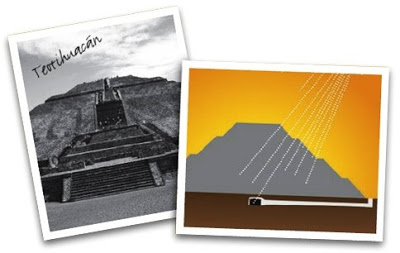 Teotihuacán
Teotihuacán
At the Pyramid of the Sun in Teotihuacán, scientists from UNAM will take advantage of an existing tunnel to place their muon detector. Muons traveling through its six gas-filled chambers will give off flashes of light.
Mayan mysteries
Schwitters is eager to answer similar questions at La Milpa in Belize.
The design of his detector is slightly different. It's a gas-filled cylinder wrapped with strips of material that detect muons as they enter and leave. Another detector, at the bottom of the cylinder, picks up flashes of light from muons zipping through the gas.
Rather than putting his detector directly below the pyramid, which would require digging a tunnel, Schwitters plans to place two detectors in shallow shafts on either side of the structure and 50 to 60 meters apart. This will give them a stereo view of the site, eliminate blind spots and make it easier to construct a 3D image. Only the most energetic muons will be used for the reconstruction; since they are not as easily deflected, their paths through the site are truer and more direct. Schwitters says it should take about 10 days to record and trace 1000 muon arrivals.
While waiting for the funding they need to set up a laboratory in Belize, Schwitters and his team have been testing the 16-foot-long prototype detector they built at the University of Texas at Austin. Big stacks of bricks stand in for the stony bulk of the pyramid; the team moves the bricks up onto the roof and into other difficult positions to see how the detector handles the challenge. From the data, Schwitters and his group can see not only the piles of bricks, but also the shadows of the nearby engineering and physics buildings, massive structures that impede the flow of muons. If the detector can distinguish these dense objects, Schwitters says, it can find cavities as well.
"The technology has really improved since the time of Alvarez," Schwitters says. "The detectors are simpler and more robust. We are looking to make the detector more portable and improve our software, and then we can get serious."
Designing the detector is the first of many challenges for the Schwitters team. Once they get funding and permission, they will have to transport the detectors to Belize and dig holes in which to put them. They'll also need to find a way to power the lab at the remote site. "It’s a slow process and we’ve got a lot to do here," Schwitters says, adding that he hopes to move to Belize by the spring of 2009.
La Milpa remains shrouded in mystery. Hammond says, "Some questions we cannot yet answer are: Why was the city founded? What was its strategic or economic importance? Why did it collapse? And why was it abandoned in a time of great construction?" Muon detection may answer at least some of these questions and give archaeologists enough of an edge to unearth the next exciting discovery.
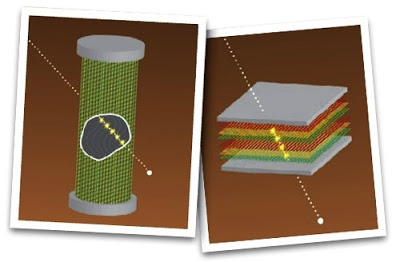
At left: This detector, developed for use at La Milpa in Belize, snags incoming muons in two ways. First, a muon’s trajectory is recorded by three layers of material wrapped around a cylindrical chamber. Meanwhile, photodetectors pick up flashes of light generated as muons strike molecules of gas inside the chamber.
At right: The detector developed by UNAM for the Pyramid of the Sun contains layers of scintillating material; they collect light produced when muons interact with gas in the detector’s six chambers.
- Physicist's Use Of Ancient Lead Is Not Making Archaeologists Happy
"Lead extracted today is naturally contaminated with the isotope Pb-210, which prevents it from being used as shielding for particle detectors".... Is this true? "Use of ancient lead in modern physics experiments ignites debate" November 29th, 2013...
- Don't Anger The Mayan Gods
"Idiot Construction Crew Demolishes 2,300-year-old Maya Pyramid" by George Dvorsky May 15th, 2013 io9 An investigation is now underway after one of the largest Maya pyramids in Belize was bulldozed to extract materials for a road project. Stuff like...
- That's The Way The Cookie [pyramids] Crumbles
"Mystery Solved? A New Theory About Why Egypt Stopped Building Pyramids" Is it possible they were too perfect? by Rebecca J. Rosen May 10th 2013 The Atlantic When structural engineer Peter James arrived at the Bent Pyramid, 25 miles south* of Cairo,...
- New Egyptian Pyramids Found By Using Nasa Technology
"Lost Egyptian Pyramids Found?" by Rossella Lorenzi August 10th, 2012 DiscoveryNewsTwo possible pyramid complexes might have been found in Egypt, according to a Google Earth satellite imagery survey.Located about 90 miles apart, the sites contain unusual...
- Physics, Art--leonardo Style
Particle events depicted as books. The few stacked neatly in piles are events selected by the CMS high-level trigger system for further study; more than 99 percent have been rejected and tossed in a pile. "Channeling da Vinci" A physicist sketches science...
Philosophy
Pyramids probe by physics
 Now physics will probe the ancient pyramids.
Now physics will probe the ancient pyramids."Secrets of the Pyramids"
by
Haley Bridger
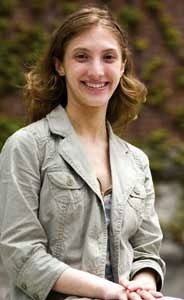 Symmetry
Symmetry
March/April 2008
Volume 5, Issue 2
In a boon for archaeology, particle physicists plan to probe ancient structures for tombs and other hidden chambers. The key to the technology is the muon, a cousin of the electron that rains harmlessly from the sky.
by
Haley Bridger
 Symmetry
SymmetryMarch/April 2008
Volume 5, Issue 2
In a boon for archaeology, particle physicists plan to probe ancient structures for tombs and other hidden chambers. The key to the technology is the muon, a cousin of the electron that rains harmlessly from the sky.
 In the dense jungles of northwestern Belize, the sound of metal hitting rock startles flocks of tropical birds and troops of black howler monkeys. Archaeologist Norman Hammond and his team stop digging. They have hit a stone wall 10 feet below ground; inside is a royal tomb. After almost one hundred test excavations at La Milpa, an ancient Mayan city of 50,000 people, Hammond has unearthed something big. Within the tomb lie the remains of a man wearing a jade pendant in the form of a vulture's head. He is thought to be either Bird Jaguar, the fifth-century ruler of La Milpa, or one of Bird Jaguar’s successors. And finding him was an incredible stroke of luck. Hammond made his famous discovery more than 10 years ago, but repeated efforts to find other tombs at the site have come up empty-handed. Lacking an ancient map of La Milpa or blueprints for its five pyramid mounds and buried plaza, archaeologists rely mostly on instinct. They run the risk of piercing priceless relics with their shovels or digging fruitlessly for years. The ground beneath the site "could be Swiss cheese, for all we know," riddled with burial chambers, tunnels, and hidden entrances, says Hammond, who is based at Boston University. Now researchers hope to find those hidden spaces with the help of particle physics.
In the dense jungles of northwestern Belize, the sound of metal hitting rock startles flocks of tropical birds and troops of black howler monkeys. Archaeologist Norman Hammond and his team stop digging. They have hit a stone wall 10 feet below ground; inside is a royal tomb. After almost one hundred test excavations at La Milpa, an ancient Mayan city of 50,000 people, Hammond has unearthed something big. Within the tomb lie the remains of a man wearing a jade pendant in the form of a vulture's head. He is thought to be either Bird Jaguar, the fifth-century ruler of La Milpa, or one of Bird Jaguar’s successors. And finding him was an incredible stroke of luck. Hammond made his famous discovery more than 10 years ago, but repeated efforts to find other tombs at the site have come up empty-handed. Lacking an ancient map of La Milpa or blueprints for its five pyramid mounds and buried plaza, archaeologists rely mostly on instinct. They run the risk of piercing priceless relics with their shovels or digging fruitlessly for years. The ground beneath the site "could be Swiss cheese, for all we know," riddled with burial chambers, tunnels, and hidden entrances, says Hammond, who is based at Boston University. Now researchers hope to find those hidden spaces with the help of particle physics.A cosmic X-ray machine
The key to the new approach is the muon, a heavy cousin of the electron that's created when cosmic rays hit the atmosphere. Muons pass harmlessly through people and buildings; in fact, nearly 600 of them fly through your body each minute. They fascinate scientists because they’re one of the few high-energy particles raining down from the sky that can be examined for clues to the nature of the cosmos. Particle physicists started building muon detectors in the 1940s and they're still at it today; the most advanced particle detectors in the world, at the Large Hadron Collider in Geneva, Switzerland, have components that record muons created in particle collisions. But it's the ability of the muon to penetrate deep into rock and water that has archaeologists excited. Muons traveling through rock or other dense material will slow and eventually stop, while those flying through empty spaces keep going fullspeed. The idea is to catch the muons after they’ve passed through an archaeological site and measure their energies and trajectories. With this information, researchers can reconstruct their paths and compile a 3D image that reveals hidden chambers or other voids.
 La Milpa
La MilpaScientists at the University of Texas at Austin plan to place two muon detectors on either side of a pyramid at La Milpa in Belize. This arrangement gives them a stereo view of the site, making it easier to compile a 3D image.
First stop: Egypt
Muon detectors have a rich history of revealing the unusual and the unseen. Sixty years ago, scientists in Australia used them to measure layers of mountain snow. Today, Japanese scientists are testing the technology as a way to track magma rising within volcanoes, a possible sign of impending eruption. Border patrol agencies in the United States see muon detectors as a potential way to uncover radioactive materials shielded and hidden inside cargo containers and trucks.
It was about 40 years ago that archaeologists tapped muons for the first time. Luis Alvarez, a Nobel Prize-winning physicist at the University of California, Berkeley, wondered if muons might reveal chambers in the Second Pyramid of Chephren, one of the three great pyramids of Egypt, that had somehow escaped the notice of archaeologists and looters for 4500 years.
Alvarez and his team put a detector in the Belzoni Chamber, near the center of the pyramid’s base, and left it to collect muons for two years. They concluded that no additional chambers were hidden in the limestone above, although the scan was able to distinguish the four edges of the pyramid and what little remained of its smooth limestone facing. While it would have been more exciting to discover a new chamber, this information was nonetheless valuable for Egyptologists and archaeologists studying the pyramid—and it showed that the technique worked.
There are other high-tech ways to explore a ruin. Ground-penetrating radar reflects off buried features, while electrical-resistivity probes measure the increased resistance to electrical flow due to the presence of stone and brick. Though useful, neither of them probes as deeply or takes as wide a view as the muon detector does.
 Egypt
EgyptIn the first experiment of its kind, a team led by Luis Alvarez placed a muon detector in a chamber of Egypt’s Second Pyramid of Chephren. Although the muons revealed no hidden chambers, the experiment showed that the method had value for archaeology.
In the early 1970s, a pair of archaeologists cleared stone and gravel out of a well at the base of the world’s third-largest pyramid, the Pyramid of the Sun at Teotihuacán. Beneath the rocks they found a stairway leading to a tunnel 100 meters long and eight meters below ground. It opened an extraordinary opportunity for the physics community, Menchaca-Rocha says: "It is the key that will allow us to carry out an experiment similar to that of Alvarez" by placing a muon detector directly below the pyramid.
Menchaca-Rocha hopes to put the detector in place this fall and begin collecting data by the end of the year.
The detector contains six gas-filled chambers. When a muon travels through one of them, it collides with particles in the gas and gives off light. By recording those light flashes and noting exactly where the muon entered and left the chamber, researchers can calculate its energy and trajectory. Menchaca-Rocha thinks the detector will reveal any cavity more than 75 centimeters—30 inches—tall.
The results could help to answer a question that has stumped archaeologists for decades: What was the purpose of the pyramid?
Linda Manzanilla, an archaeologist with UNAM, studies Teotihuacán, once a bustling center full of pyramids and temples. "It was a city that attracted many people," she says, "and it flourished for five centuries." She believes a volcanic eruption drove people from the north towards the valley where the metropolis rose; "There they built a temple to appease the fire gods."
Originally devoted to agriculture, the temple became a symbol of the state and its rulers. Could one of those rulers lie in a tomb within the Pyramid of the Sun? "I don’t think so. I don’t believe we will find anything inside," Manzanilla says. No tombs have been found there yet, and she doesn’t think that will change.
But without a muon detector, Manzanilla can't test her predictions. "The Pyramid of the Sun is so wide and so high," she says. "Ground-penetrating radar can see only a small depth and width. We can expand that view using the muon detector."
And, she hopes, put to rest speculation about what is inside.
 Teotihuacán
TeotihuacánAt the Pyramid of the Sun in Teotihuacán, scientists from UNAM will take advantage of an existing tunnel to place their muon detector. Muons traveling through its six gas-filled chambers will give off flashes of light.
Schwitters is eager to answer similar questions at La Milpa in Belize.
The design of his detector is slightly different. It's a gas-filled cylinder wrapped with strips of material that detect muons as they enter and leave. Another detector, at the bottom of the cylinder, picks up flashes of light from muons zipping through the gas.
Rather than putting his detector directly below the pyramid, which would require digging a tunnel, Schwitters plans to place two detectors in shallow shafts on either side of the structure and 50 to 60 meters apart. This will give them a stereo view of the site, eliminate blind spots and make it easier to construct a 3D image. Only the most energetic muons will be used for the reconstruction; since they are not as easily deflected, their paths through the site are truer and more direct. Schwitters says it should take about 10 days to record and trace 1000 muon arrivals.
While waiting for the funding they need to set up a laboratory in Belize, Schwitters and his team have been testing the 16-foot-long prototype detector they built at the University of Texas at Austin. Big stacks of bricks stand in for the stony bulk of the pyramid; the team moves the bricks up onto the roof and into other difficult positions to see how the detector handles the challenge. From the data, Schwitters and his group can see not only the piles of bricks, but also the shadows of the nearby engineering and physics buildings, massive structures that impede the flow of muons. If the detector can distinguish these dense objects, Schwitters says, it can find cavities as well.
"The technology has really improved since the time of Alvarez," Schwitters says. "The detectors are simpler and more robust. We are looking to make the detector more portable and improve our software, and then we can get serious."
Designing the detector is the first of many challenges for the Schwitters team. Once they get funding and permission, they will have to transport the detectors to Belize and dig holes in which to put them. They'll also need to find a way to power the lab at the remote site. "It’s a slow process and we’ve got a lot to do here," Schwitters says, adding that he hopes to move to Belize by the spring of 2009.
La Milpa remains shrouded in mystery. Hammond says, "Some questions we cannot yet answer are: Why was the city founded? What was its strategic or economic importance? Why did it collapse? And why was it abandoned in a time of great construction?" Muon detection may answer at least some of these questions and give archaeologists enough of an edge to unearth the next exciting discovery.

At left: This detector, developed for use at La Milpa in Belize, snags incoming muons in two ways. First, a muon’s trajectory is recorded by three layers of material wrapped around a cylindrical chamber. Meanwhile, photodetectors pick up flashes of light generated as muons strike molecules of gas inside the chamber.
At right: The detector developed by UNAM for the Pyramid of the Sun contains layers of scintillating material; they collect light produced when muons interact with gas in the detector’s six chambers.
If you are interested in Egypt and Egyptology , then visit colleague's [Andie Byrnes] informative and daily updated blog.
Egyptology News
And...
Classic Egyptology
Egyptology News
And...
Classic Egyptology
- Physicist's Use Of Ancient Lead Is Not Making Archaeologists Happy
"Lead extracted today is naturally contaminated with the isotope Pb-210, which prevents it from being used as shielding for particle detectors".... Is this true? "Use of ancient lead in modern physics experiments ignites debate" November 29th, 2013...
- Don't Anger The Mayan Gods
"Idiot Construction Crew Demolishes 2,300-year-old Maya Pyramid" by George Dvorsky May 15th, 2013 io9 An investigation is now underway after one of the largest Maya pyramids in Belize was bulldozed to extract materials for a road project. Stuff like...
- That's The Way The Cookie [pyramids] Crumbles
"Mystery Solved? A New Theory About Why Egypt Stopped Building Pyramids" Is it possible they were too perfect? by Rebecca J. Rosen May 10th 2013 The Atlantic When structural engineer Peter James arrived at the Bent Pyramid, 25 miles south* of Cairo,...
- New Egyptian Pyramids Found By Using Nasa Technology
"Lost Egyptian Pyramids Found?" by Rossella Lorenzi August 10th, 2012 DiscoveryNewsTwo possible pyramid complexes might have been found in Egypt, according to a Google Earth satellite imagery survey.Located about 90 miles apart, the sites contain unusual...
- Physics, Art--leonardo Style
Particle events depicted as books. The few stacked neatly in piles are events selected by the CMS high-level trigger system for further study; more than 99 percent have been rejected and tossed in a pile. "Channeling da Vinci" A physicist sketches science...
